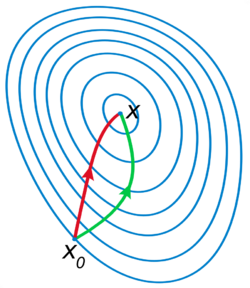🔬 Problem set gamma#
\(\gamma\).1#
Let \(A\),\(B\) and \(C\) be any three sets. Show that \(A \cap (B \cup C) = (A\cap B) \cup (A \cap C)\).
One way to show that \(E=F\) is show that a arbitrary element of \(E\) must also be in \(F\) and vice versa.
Let \(A, B\) and \(C\) be any three sets, as in the question. Let
We need to show that \(E = F\), or, equivalently, that \(E \subset F\) and \(F \subset E\).
To see that \(E \subset F\), pick any \(x \in E\). We claim that \(x \in F\) also holds. To see this, observe that since \(x \in E\), it must be true that \(x\) is in \(A\) as well as being in at least one of \(B\) and \(C\). In the first case \(x\) is in both \(A\) and \(B\). In the second case \(x\) is in both \(A\) and \(C\). In either case we have \(x \in F\) by the definition of \(F\).
To see that \(F \subset E\), pick any \(x \in F\). We claim that \(x \in E\) also holds. Indeed, since \(x \in F\) we know that either \(x\) is in both \(A\) and \(B\) or \(x\) is in both \(A\) and \(C\). In other words, \(x\) is in \(A\) and also at least one of \(B\) and \(C\). Hence \(x \in E\).
\(\gamma\).2#
Let \(A\), \(B\), \(C\) and \(D\) be some set such that \(A \subset C\) and \(B \subset C\). Let \(f\colon D \rightarrow C\) be a function.
Show that \(f^{-1}(A \setminus B) = f^{-1}(A) \setminus f^{-1}(B)\).
Note the definitions that \(f^{-1}(A) := \{x\in D\colon f(x) \in A \}\) and \((f^{-1}(B))^c = \{x\in D\colon f(x) \notin B\}\).
To show the equality we can prove the the left hand side (LHS) implies the right hand side (RHS), i.e. LHS \(\Rightarrow\) RHS, and then show that RHS \(\Rightarrow\) LHS. These two steps are usually referred to as necessity and sufficiency (of the RHS for LHS).
Necessity: assume \(x \in f^{-1}(A \setminus B)\), then \(f(x) \in A\) and \(f(x) \notin B\), and so \(x \in f^{-1}(A)\) and \(x \notin f^{-1}(B)\).
Sufficiency: if \(x \in f^{-1}(A) \setminus f^{-1}(B)\), then \(f(x) \in A\) and \(f(x) \notin B\), and so \(x \in f^{-1}(A \setminus B)\).
\(\gamma\).3#
Find the composition \(g \circ f\) of two functions \(f\) and \(g\), if it exists:
\(f \colon \mathbb{R} \rightarrow \mathbb{R}\) defined by \(f(x)=\sin(x)\) and \(g \colon \mathbb{R} \rightarrow \mathbb{R}\) defined by \(g(x)= \frac{x}{1+x^2}\)
\(f \colon \mathbb{R} \rightarrow \mathbb{R}\) defined by \(f(x)= 1-x^4\) and \(g \colon (1,\infty) \rightarrow \mathbb{R}\) defined by \(g(x)= \log(x-1)\)
\(f \colon \mathbb{R} \rightarrow \mathbb{R}\) defined by \(f(x)=\cos(x)\) and \(g \colon \mathbb{R}\setminus\{1\} \rightarrow \mathbb{R}\) defined by \(g(x)= \frac{x}{1-x}\)
Is there a composition in each case?
The issue we have to deal with is the compatibility of the domains and ranges of the functions.
All good
The range of \(f(x)\) and the domain of \(g(x)\) are disjoint, so the composition is not defined.
The points where \(f(x)=1\) have to be excluded in the composition
\(\gamma\).4#
Let \(f\) and \(g\) be any two functions from \(\mathbb{R}\) to \(\mathbb{R}\). Is it true that \(g \circ f = f \circ g\) always holds?
There are two things implicit in this question.
First, there is an implicit final sentence here, which is: If yes, prove it. If no, give a counterexample.
Second, an equality sign between two functions means that they are the same function. Hence to show equality you need to show that they agree everywhere on the domain. To show inequality, you need to give just one point in the domain where the function values differ.
This is not always true. For example, if \(f(x) = x^2\) and \(g(x) = 4x\), then \(g \circ f\) and \(f \circ g\) differ. Indeed, if we set \(x=1\), then
while
Hence \(g \circ f \not= f \circ g\) as claimed.
Note
Can you think of restrictions on \(f\) and \(g\) that would make the claim true?
\(\gamma\).5#
For each of the following functions, what is its domain and range? Is it one-to-one? Is it onto? Is it bijective? If it is bijective, write the expression for the inverse function.
\(f(x) = 3x-7\)
\(f(x) = e^x\)
\(f(x) = \ln(x)\)
\(f(x) = \sqrt{x-1}\)
\(f(x) = x^2-1\)
Draw a graph for each function.
\(f(x) = 3x-7\)
Domain: \(\mathbb{R}\)
Range: \(\mathbb{R}\)
One-to-one?
YesOnto?
YesBijective?
YesInverse: \(f^{-1}(y) = \frac{y+7}{3}\)
\(f(x) = e^x\)
Domain: \(\mathbb{R}\)
Range: \(\mathbb{R}_{++} = \{x \in \mathbb{R}: x>0\}\)
One-to-one?
YesOnto?
No, not on \(\mathbb{R}\), but if we restrict the domain to \(\mathbb{R}_{++}\), thenYes, we can think of \(f(x)\) as a surjection (onto) from \(\mathbb{R}\) to \(\mathbb{R}_{++}\)Bijective?
Nofor \(f(x): \mathbb{R} \to \mathbb{R}\),Yesfor \(f(x): \mathbb{R} \to \mathbb{R}_{++}\)Inverse: \(f^{-1}: \mathbb{R}_{++} \ni y \mapsto \ln(y) \in \mathbb{R}\)
\(f(x) = \ln(x)\)
Domain: \(\mathbb{R}_{++} = \{x \in \mathbb{R}: x>0\}\)
Range: \(\mathbb{R}\)
One-to-one?
YesOnto?
YesBijective?
YesInverse: \(f^{-1}: \mathbb{R} \ni y \mapsto e^y \in \mathbb{R}_{++}\)
\(f(x) = \sqrt{x-1}\)
Domain: \(\mathbb{R}_{+} = [1,\infty) = \{x \in \mathbb{R}: x \ge 1\}\)
Range: \(\mathbb{R}_{+}\)
One-to-one?
YesOnto?
Yesfor \(f: \mathbb{R}_{+} \to \mathbb{R}_{+}\)Bijective?
YesInverse: \(f^{-1}(y) = y^2+1\)
\(f(x) = x^2-1\)
Domain: \(\mathbb{R}\)
Range: \([-1,\infty) = \{x \in \mathbb{R}: x \ge -1\}\)
One-to-one?
NoOnto?
Yesfor \(f: \mathbb{R} \to [-1,\infty) \subset \mathbb{R}\),Nofor \(f: \mathbb{R} \to \mathbb{R}\)Bijective?
Nobecause it is not injection (one-to-one)Inverse: undefined because \(f\) is not bijective
